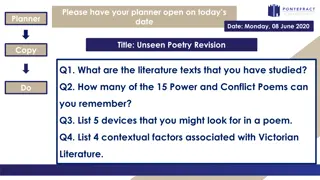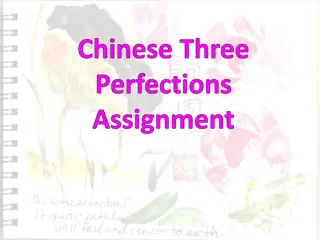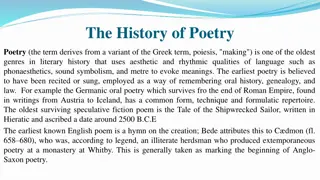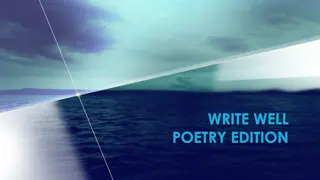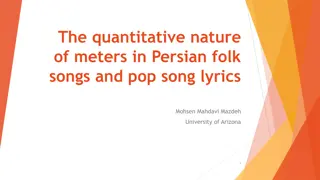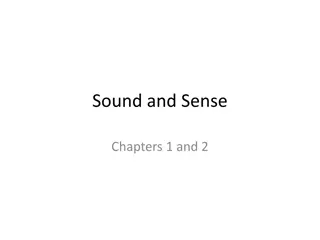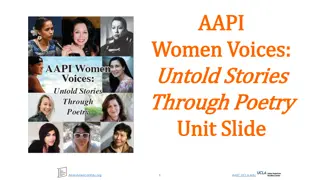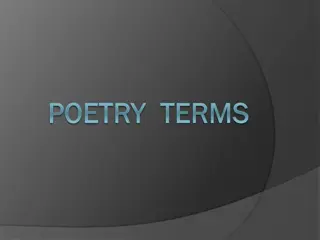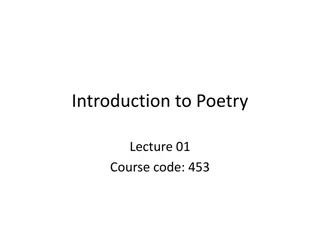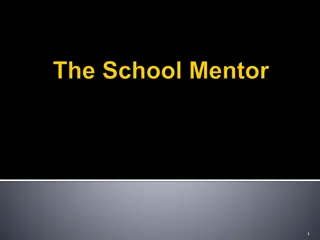Exploring the World of Poetry: A Comprehensive Guide for Parents and Teachers
Delve into the world of poetry with this comprehensive guide designed to introduce children to the art of poetic expression. Learn about famous poets, discover the benefits of incorporating poetry at home and in the classroom, and explore resources to enhance your and your child's poetic journey.
Download Presentation

Please find below an Image/Link to download the presentation.
The content on the website is provided AS IS for your information and personal use only. It may not be sold, licensed, or shared on other websites without obtaining consent from the author.If you encounter any issues during the download, it is possible that the publisher has removed the file from their server.
You are allowed to download the files provided on this website for personal or commercial use, subject to the condition that they are used lawfully. All files are the property of their respective owners.
The content on the website is provided AS IS for your information and personal use only. It may not be sold, licensed, or shared on other websites without obtaining consent from the author.
E N D
Presentation Transcript
Poetry is life distilled. ~ Gwendolyn Brooks ~ Gwendolyn Brooks ~
TABLE OF CONTENTS TABLE OF CONTENTS Introduce Children to Lives of Poets Introduce Children to Lives of Poets Parent s Guide Parent s Guide Why Introduce Poetry at Home? Introducing Poetry at Home Writing Poetry at Home Teacher s Guide Teacher s Guide Poetry Key Terms Why Incorporate Poetry in the Classroom? Before Introducing Poetry in the Classroom Introducing Poetry in the Classroom Writing Poetry in the Classroom
Introduce Children to the Lives of Poets Introduce Children to the Lives of Poets Many poets write poems about their mood, life events, family and relationships, and nature. Studying and learning about poets can help children better understand poetry. Learning the background of a poet and the time period a poem was written is essential in understanding and drawing conclusions about a poem s meaning. Resources: Resources: 10 Wonderful Poets You Should Know https://lithub.com/10-wonderful-childrens-poets-you- should-know/ Exquisite: The Poetry and Life of Gwendolyn Brooks by Suzanne Slade (Retails for $17.99) https://www.amazon.com/Exquisite-Poetry-Life-Gwendolyn-Brooks/dp/1419734113 https://www.barnesandnoble.com/w/exquisite-suzanne-slade/1132798966 https://www.abramsbooks.com/product/exquisite_9781419734113/ Search more than 3,000 biographies of contemporary and classic poets https://poets.org/poets?gclid=CjwKCAjwn6GGBhADEiwAruUcKi8xJayZ-D_Rp9gps- sp2RQIllGrxXJwCTUwLqgv1N3kpnSTwssl5xoCdKcQAvD_BwE
PARENTS GUIDE PARENT S GUIDE
Why Introduce Poetry at Home? Why Introduce Poetry at Home? Rhyming can assist in your child learning words through both audible and visual means. The structure of poetry makes use of pattern and sequence, creating a familiar context for unfamiliar language. Reading poetry aloud helps your child practice the way they pronounce words. Essential in aiding memory and language development. Reading aloud also gives insight on how children express emotion to words through volume and pitch. Poetry allows your child to become a successful reader and aids them in speaking. Poetry improves phonological and phonemic awareness.
Introducing Poetry at Home Introducing Poetry at Home Read poetry aloud. Read poetry aloud. Reading aloud to younger children is a way to introduce them to poetry. With older children, having them read poems aloud to you may be more appropriate. Placing emphasis on word sounds and rhymes allows the child to experience the rhythm and tones of poem. Check out: https://bookriot.com/poetry-books-for-kids/ Try using riddles. Try using riddles. Riddles are extremely helpful in getting the kids to be more creative and think outside the box and then add rhymes to the riddles. Play rhyming games. Play rhyming games. Word association games can help children create similes, metaphors and analogies. Try giving your child a sentence, then help them reply with a sentence that rhymes. Jot down those rhyming sentences and add more sentences to create a rhyming story (that s a poem)! Make poetry portable Make poetry portable. Download digital library apps on your child s tablet and/or other electronic devices to be able to easily access a range of resources on poetry. Check out: https://www.getepic.com/promo?signUpV=create_account
Writing Poetry at Home Writing Poetry at Home Write a poem together. Write a poem together. Try something fictional, something based on a real story and something specifically for a special occasion. If you want to go one step further, get some crayons and turn the poem into pictures! Choose fun and interesting topics. Choose fun and interesting topics. For younger children, choose playful, rhyming poetry about topics that are familiar and of interest to them. For older children who already have a strong grasp on phonemic awareness, you can explain that poetry doesn't always have to rhyme. Experiment Experiment with different types of poetry. Two common types are: with different types of poetry. Two common types are: 1. 1. Haiku Haiku - consists of three lines with 5 syllables in the first line, 7 syllables in the second line and 5 syllables in the third line. For examples of this type of poem, check out: https://www.familyfriendpoems.com/poems/other/haiku/ 2. 2. A Acrostic poems crostic poems - where the first letter of each line spells out a word, message or the alphabet. For examples of this type of poem, check out: https://www.familyfriendpoems.com/poems/other/acrostic/ Incorporate cultural traditions in your poems Incorporate cultural traditions in your poems. If you can speak another language, try adding in words from your native tongue, or translations of your favorite words into poetry writing. This is a creative method to teach your child more about their cultural background.
TEACHERS GUIDE TEACHER S GUIDE
P Poetry oetry K Key ey T Terms erms Cadence Cadence - The patterning of rhythm in natural speech, or in poetry without a distinct meter. Meter Meter - The rhythmical pattern of stressed and unstressed syllables in verse. Refrain Refrain - A phrase or line repeated at intervals within a poem, especially at the end of a stanza. Rhyme Rhyme - The repetition of syllables, typically at the end of a verse line. Rhymed words conventionally share all sounds following the word s last stressed syllable. Stanza Stanza - a group of lines forming the basic recurring metrical unit in a poem; a verse. Tone Tone - The poet s attitude toward the poem s speaker, reader, and subject matter, as interpreted by the reader. Verse Verse - writing arranged with a metrical rhythm, typically having a rhyme.
Why Incorporate Poetry in the Classroom? Why Incorporate Poetry in the Classroom? Poetry opens venues for speaking and listening. Poetry helps students learn about each other by allowing them to express segments of their lives, describe lived experiences, even parts they wouldn t openly share. Poetry can spark discussion, curiosity, and prior knowledge, ultimately building excitement and anticipation in students. Poetry is an effective method to inspire students to write. Poetry is universal and creates a space for English Language Learners (ELL) as they can read poetry in their primary language. Poetry tends to defy formal grammar rules thus allowing ELL students be expressive despite language barriers or limited vocabulary. Poetry builds resilience in kids and adults and promotes Social and Emotional Learning. Schools are places learning through too much of "brain only;" poetry provides a ways of being and other modes of learning.
What to Know Before Introducing Poetry in the Classroom What to Know Before Introducing Poetry in the Classroom Some poems are challenging to understand, even for adults so teaching students how to analyze poems is not always easy. It is essential that you spend time reading and analyzing poetry yourself and fully understand it before you attempt teach it to students. Spend time to think, reflect, ask questions about what you ve read.
Introducing Poetry in the Classroom Introducing Poetry in the Classroom Set the Scene Set the Scene - - Set up a poetry corner or space in your classroom dedicated to get students enthusiastic and keep them excited about reading poetry. Put poetry and/or poetry books written by other students on display in the poetry corner . Establish a theme Establish a theme - - Consider teaching poetry with a theme and include accompanying guiding questions that allows students to construct the theme and essential questions for themselves. Introduce diverse poetry that students can relate to Introduce diverse poetry that students can relate to - - Many students have a preconceived notion that poetry is boring, for older people, or for girls, so using poetry they can relate to can be a great way to hook students from the very beginning! Reread poems with students more than once Reread poems with students more than once - - The first time students hear a poem, they are so engrossed in the story the poem is trying to tell that they miss all the poetry elements. Reading a poem multiple times, they can start to listen for the important components. When rereading the poem, ask students to listen for patterns and for the overall flow of the words.
Writing Poetry in the Classroom Writing Poetry in the Classroom Help students analyze Help students analyze poetry they have read to begin writing. poetry they have read to begin writing. Identify any words stand out? Think about why the author may have chosen the words she or he did? What may the author be trying to convey in the poem? Having students answer these questions help to create the mood, feeling tone, and message of the poems they have read and their own poems they will write. Write a poem Write a poem of your own while the students are writing theirs. of your own while the students are writing theirs. Share your writing process such as drafts, failures, and successes with your students. When students observe that poetry is a genuine interest to you, they tend to be more open to asking questions and you ll be better equipped to address their questions about the writing process. Encourage students to put themselves into their poems. Encourage students to put themselves into their poems. It is important to encourage students share their thoughts and feelings in their writing. When students communicate their emotions, unique ideas, and opinions in their poems, their poems become representative of who they really are, and as a result, readers and listeners understandably will be much more interested in what they have to say. Encourage the use of metaphors and similes Encourage the use of metaphors and similes - - By comparing one thing to another, the writer can evoke a mood or memory, help the reader to make connections, establish a theme, and add interest and color to the writing.
Writing Poetry in the Classroom Writing Poetry in the Classroom Mix up the verse style of poetry you will teach Mix up the verse style of poetry you will teach Learning an hour of limericks can get tired quickly. Mix it up and bounce between teaching other verse styles of poetry. Consider: 1. 1. Rhymed Verse Rhymed Verse - the most common and it usually has a metrical form that rhymes throughout. 2. 2. Blank Verse Blank Verse - is described to have a metrical form but no rhyme. 3. 3. Free Verse Free Verse - is described to have no set meter but may or may not be rhymed. Encourage students to read poems written by other students Encourage students to read poems written by other students. . For examples of award- winning poetry written by other students, check out: https://www.ilhumanities.org/app/uploads/2017/04/Gwendolyn-Brooks-Youth-Poetry- Awards-Chapbook-2020.pdf
Encourage Students to Submit Their Poems to Contests Check out: https://www.ilhumanities.org/program/gw endolyn-brooks-youth-poetry-awards/
References https://www.sassymamahk.com/learn-poetry-introduce-children-language/ https://bookriot.com/poetry-books-for-kids/ https://poets.org/poets https://www.edutopia.org/blog/five-reasons-poetry-needed-schools-elena-aguilar https://www.ilhumanities.org/program/gwendolyn-brooks-youth-poetry-awards/
References https://allpoetry.com/book https://mrsrenz.com/10-poetry-tips/ https://www.edutopia.org/article/6-tips-teaching-poetry-writing-teens https://www.youngwriters.co.uk/info/other/poetry-terms/verse
FOR QUESTIONS OR COMMENTS? Please email us at: poetry@ilhumanities.org This DIY guide was prepared by LaWanda R. McCraney (Adler University Doctoral Student / SJP Intern) for Illinois Humanities / Gwendolyn Brooks Youth Poetry Awards (GBYPA)





